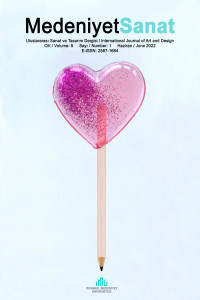On Altıncı Yüzyıl Erken Dönem Basılı Kitaplarda İtalik Yazı Biçeminin Kullanımı Üzerine Genel Bir Bakış
Günümüzde italik yazı biçemi genellikle metin elemanlarını ayrıştırmak ve Roma yazı biçemiyle oluşturulmuş bir metnin içerisindeki kelimeleri farklılaştırarak, onları vurgulamak için kullanılır. Bunun dışında, akademi ve edebiyatta da italik biçeminin kullanımına ilişkin birçok farklı kural mevcuttur. Bununla birlikte, erken dönemde basılan kitaplardaki italik biçeminin kullanımı ve hatta tasarlanma amacı, bugünkünden farklıydı. Bu makale, on altıncı yüzyıl erken dönem kitaplarında kullanılan farklı italik kullanımlarını kısaca ortaya koymayı amaçlamakta ve zaman içerisinde italik biçeminin roma biçemine nasıl yardımcı unsur haline geldiği sorusunu cevaplamak için italik kullanımın izini sürmektedir. Bunu gerçekleştirmek için ise, baskı harfleri ve italik üzerine bilinen çalışmalar gözden geçirilmiş olup, bu çalışmada kullanılmak üzere örnek seçiminde bunlardan faydalanılmıştır. Ek olarak, orijinal materyallerin görseline ulaşmak için bazı online veritabanları ve web sayfaları taranmıştır. Makale iki ana bölümden oluşmaktadır. İlk bölümde italik biçeminin yaratılmasına zemin hazırlayan dönemin şartlarını anlamak için İtalya ve Fransa’da bunun ilk ortaya çıkışıyla ilgili kısa bir tarihsel bilgi verilmiştir. Roma yazı biçemine yardımcı olarak kompleks tipografi uygulamalarındaki ilk ve sonraki dönemlerde geliştirilmiş kullanımlar ise son bölümde ortaya koyulmuştur. İnceleme sonucunda, sadece yarım yüzyıl içerisinde, italik yazı biçeminin metin ve sayfa elemanlarını farklılaştırmada roma yazı biçemi için etkin bir yardımcı haline geldiği ve başlıklar, şiirler, resim altı yazısı ve kenar notu gibi bölümlerde kullanılarak çok yönlü zengin metinler dizmeyi mümkün kıldığı gözlemlenmiştir. Buna ek olarak, küçük-büyük harfleri, ince ve kalın yazıları içeren yeni harf formlarının ve biçemlerinin yaratılmasının da yolunu açmıştır.
Anahtar Kelimeler:
tipografi, İtalik Harf, erken dönem kitaplar, Aldus Manutius, Francesco Griffo
An Overview of the Usage of Italic Style in Early Printed Books of the Sixteenth-Century
The aim of the usage of italic style in the current era is mainly for differentiating the text elements, putting emphasis on words or making contrast in a Roman text. In addition, there are various certain rules of using italics in literature and the academic world. However, the usage and even the design motive of italic style in early printed books had a very different purpose than today’s approach. This article aims to reveal the different usages of italic style in early printed books of the sixteenth-century briefly, and traces the journey of italic usage to answer how it became an auxiliary to roman in time. To achieve this, well-known studies on printing types and italics were reviewed and utilised to choose exemplars for this study. In addition to this, some of the online databases and websites were scanned to access the image of original materials. This article is consist of two main parts; in the first part, a brief historical background about the italic type and its appearances in Italy and France are mentioned to understand the circumstances of the era that paved the way for its creation and use. In the last part, the initial and enhanced usages in complex typography as auxiliary to roman text are revealed. As a result of the review, it is observed that italic style became an efficient auxiliary to roman style in a half century, after its creation and was used for differentiating text and page elements to set more sophisticated texts, as being devised in headings, poems, picture captions, sidenotes etc. Furthermore, the invention of it also inspired many typographers to create new type forms and styles, including small capitals, light and bold.
Keywords:
Typography, Italic Type, Early Books, Aldus Manutius, Francesco Griffo,
___
- Carter, H. (2002). A View of Early Typography, Up to About 1600. Oxford: Hyphen Press.
- Clair, C. (1976). A History of European Printing. London: Academic Press Inc.
- Hamilton, C. (1918). The Uses of Italic. Chicago: United Typothetae of America.
- Howard, N. (2005). The Book: The Life Story of a Technology. London: Greenwood Press. Lommen, M. (2012). The Book of Books: 500 Years of Graphic Innovation. London: Thames & Hudson. Morison, S. (1949). Four Centuries of Fine Printing. London: Ernest Benn Limited.
- Nolhac, P. (1888). Les correspondants d'Alde Manuce: matériaux nouveaux d'histoire littéraire, 1483-1514. Vatican City: Impr. Vaticane.
- Steinberg, S. (1949). Five Hundred Years of Printing. London: British Library & Oak Knoll Press.
- Twyman, M. (1982). The Graphic Presentation of Language. Information Design Journal: vol:3, no:1: 2-22.
- Updike, D. B. (1962). Printing Types, Their History, Forms, and Use. London: Oxford University Press.
- Vervliet, H.D.L.(2010). French Renaissance Printing Types: A Conspectus. London: Oak Knoll Press.
- Image References
- Figure 1. Available from: http://charlesricketts.blogspot.com/2017/02/ [Accessed: 13th December 2019].
- Figure 2. Lommen, M. (2012). The Book of Books: 500 Years of Graphic Innovation. London: Thames & Hudson, p.85. Figure 3. Available from: https://rarebooks.library.nd.edu/exhibits/durand/images/italian/boccaccio.ts.150.jpeg [Accessed: 12th December 2019].
- Figure 4. Available from: https://www.abebooks.com/Officia-diligenter-restituta-Eiusdem-Amicitia-Senectute/30420606335/bd#&gid=1&pid=2 [Accessed: 12th December 2019].
- Figure 5. Available from: https://gallica.bnf.fr/ark:/12148/bpt6k533089/f2.item.zoom [Accessed: 13th December 2019].
- Figure 6. Lommen, M. (2012). The Book of Books: 500 Years of Graphic Innovation. London: Thames & Hudson, p.118. Figure 7. Lommen, M. (2012). The Book of Books: 500 Years of Graphic Innovation. London: Thames & Hudson, p.103 Figure 8. Available from: http://www.minervaauctions.com/aste/asta127/43096-alighieri-la-comedia-di-dante-aligieri-con-la-noua-espositione-di-alessandro-vellutello/ [Accessed: 13th December 2019].
- Figure 9. Marcus Tullus Ciceroes three bookes of dueties, 1558. Available from: https://www.shakespeare.org.uk/explore-shakespeare/blogs/cicero-collections/ [Accessed: 12th December 2019].
- Figure 10. Lommen, M. (2012). The Book of Books: 500 Years of Graphic Innovation. London: Thames & Hudson, p.129 Figure 11. Available from: https://gallica.bnf.fr/ark:/12148/bpt6k505878/f3.item.zoom [Accessed: 12th December 2019].
- Figure 12. Available from: https://www.lunascafe.org/2010/11/whole-world-in-your-hands.html [Accessed: 13th December 2019].
- Yayın Aralığı: Yılda 2 Sayı
- Başlangıç: 2015
- Yayıncı: İstanbul Medeniyet Üniversitesi
